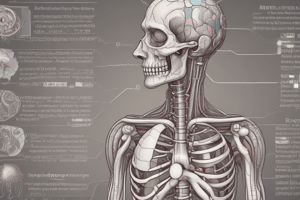Podcast
Questions and Answers
Match the following terms with their correct function:
Match the following terms with their correct function:
Peristalsis = Controls food movement into the duodenum Villi and microvilli = Increase intestinal surface area for absorption Pylorus = Controls food propulsion and stomach emptying Peyer's patches = Found in the mucosa of the ileum
Match the following organs with their secretions:
Match the following organs with their secretions:
Liver = Bile secretion Pancreas = Pancreatic juice secretion Gallbladder = Bile storage Duodenum = Receives secretions through the hepatopancreatic sphincter
Match the following structures with their locations:
Match the following structures with their locations:
Circular folds = Found in the small intestine Serosa = Covers most of the digestive organs Adventitia = Covers the duodenum Smooth muscle sheet with pacemaker cells = Sets the rate of peristalsis in the stomach
Match the following substances with their properties:
Match the following substances with their properties:
Match the following terms with their respective functions in digestion:
Match the following terms with their respective functions in digestion:
Flashcards are hidden until you start studying
Study Notes
Overview of the Digestive System
- The digestive system consists of organs of the alimentary canal and accessory digestive system organs.
- The alimentary canal includes: mouth, pharynx, esophagus, stomach, small and large intestines.
- Accessory digestive system organs include: teeth, tongue, salivary glands, liver, gallbladder, and pancreas.
Digestive Processes
- The six digestive processes are: ingestion, propulsion, mechanical breakdown, digestion, absorption, and defecation.
- Ingestion is the intake of food.
- Propulsion is the movement of food through the tract.
- Mechanical breakdown is the physical mixing or breaking of food into smaller fragments.
- Digestion is the breakdown of food by enzymatic action.
- Absorption is the transport of products of digestion through the intestinal mucosa into the blood.
- Defecation is the elimination of undigested residues from the body.
The Stomach
- The stomach is J-shaped and lies in the upper left quadrant of the abdomen.
- The stomach has four major regions: cardia, fundus, body, and pyloric part.
- The stomach mucosa is simple columnar epithelium with gastric pits and glands.
- Gastric glands contain secretory cells: chief cells, parietal cells, mucous neck cells, and enteroendocrine cells.
- The stomach muscularis has a third layer of smooth muscle that allows it to churn and mix food.
Gastric Secretion and Regulation
- Parietal cells secrete hydrochloric acid and intrinsic factor.
- Chief cells produce pepsinogen.
- Mucous neck cells produce mucus.
- Enteroendocrine cells secrete hormones.
- The mucosal barrier protects the stomach from self-digestion and HCl.
- Protein digestion is initiated in the stomach by activated pepsin and requires acidic conditions.
Control of Gastric Secretion
- Gastric secretion is controlled by both nervous and hormonal factors.
- The three phases of gastric secretion are cephalic, gastric, and intestinal.
- Most food-related stimuli stimulate gastric secretion.
- Vagovagal reflexes and sympathetic activity also regulate gastric secretion.
The Small Intestine
- The small intestine is the major digestive and absorptive organ.
- It has three subdivisions: duodenum, jejunum, and ileum.
- The small intestine extends from the pyloric sphincter to the ileocecal valve.
- The bile duct and pancreatic duct join to form the hepatopancreatic ampulla and empty into the duodenum.
- Circular folds, villi, and microvilli increase the intestinal surface area for digestion and absorption.
- The duodenal submucosa contains elaborate mucus-secreting duodenal glands.
- The mucosa of the ileum contains Peyer's patches (lymphoid follicles).
Studying That Suits You
Use AI to generate personalized quizzes and flashcards to suit your learning preferences.




